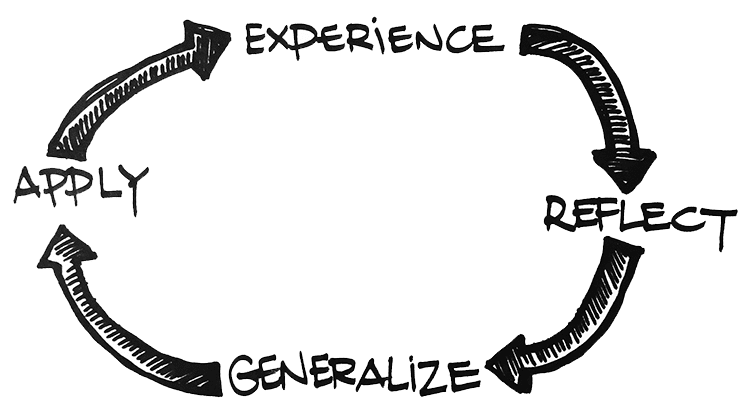Ongoing In-Class Reflection Strategies
 Try
Try
Mix up the groupings for reflection. Invite students to reflect individually, in pairs, small groups, and as a class.
 Try
Try
Use a “What? So what? Now what?” structure to encourage students to think about what they did, why they did it, and what they can do next.
 Try
Try
Incorporate moments for quick reflection throughout every lesson, and times for more in-depth reflection periodically over the course of your entire class and residency.
Learning Cycle
Building in opportunities for reflection throughout the lesson, and incorporating multiple modes of reflection, can support student learning, engagement, and growth.
- There is an experience (in the form of an activity/lesson) in the classroom. Now you can question the students: “What happened? What did we do?”
- Reflect on the experience to review and evaluate what happened. For example, students ask themselves, “What did I experience?”
- Generalize and ask, “Why did this happen?”
- Apply through active experimentation. “Consider, what will you do? What will taking action look like?”

Remote Teaching and Learning Tip
You can create breakout rooms for small-group reflection on some digital platforms. It may be a good idea to plan out the breakout rooms (the amount or who’s in each room) in advance if you need to have supervision from a Classroom Professional in each breakout room, or need a Classroom Professional to make the breakout rooms.
Remote Teaching and Learning Tip
You can use a tool, such as Poll Everywhere, Padlet, Mentimeter, etc. to create an interactive, real-time generator of a word cloud for students.
Remote Teaching and Learning Tip
You can take advantage of your class chat as an ongoing reflection strategy, using emojis, one-word reflections, etc. Another possibility is to incorporate polls (interactive Google Forms/Zoom polls, third-party interactive forms like Padlet/Poll Everywhere, and more basic “show of hands”) to utilize the digital tools as part of your reflection strategies for a synchronous remote class. You can also bring in other nonverbal reflection responses using reaction buttons, thumbs up/down, etc.


